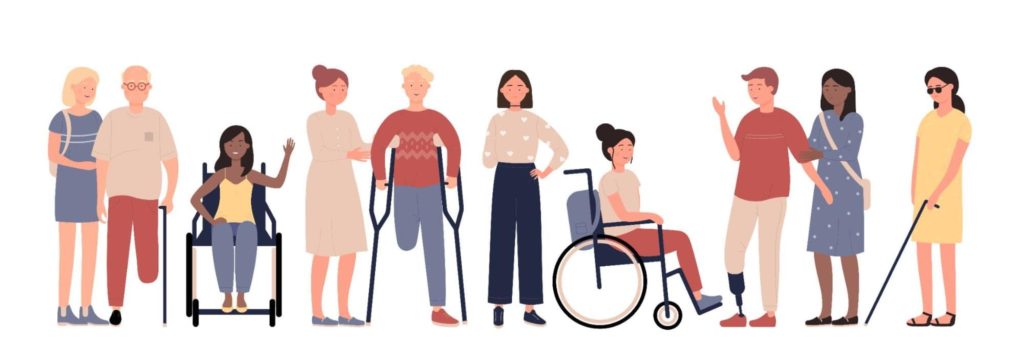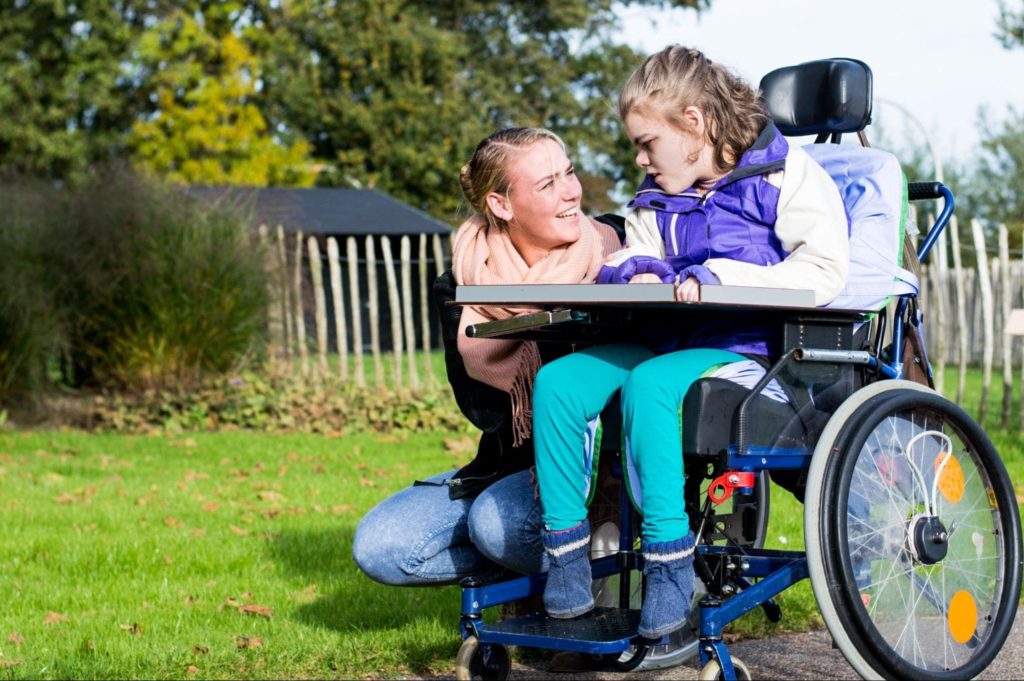
As 26% of adults in the United States have some type of disability, it is important to have the correct terminology for people with disabilities. In this blog, we will outline a solid foundation of disabilities, the different types, how they are defined, and examine if there truly are any synonyms. Concluding the blog, we will share good practices on “people first language” and resources to help expand your knowledge even more as you continue your research.
A Brief History of Disabilities
As we approach the 32nd anniversary of the Americans with Disabilities Act, let’s take a look back at how the perception of disabilities has changed over time. Before the Americans with Disabilities Act, cultures idolized the perfect body or the perfect race which left minority groups fending for themselves.
Between the 1940s and 1950s, publications and campaigns came out that began to advocate for people with disabilities and their rights. In 1973, the Rehabilitation Act was passed which was meant to eliminate discrimination in federally funded programs and services.
When The International Year of Disabled Persons came in 1981, it advocated for governments to sponsor programs that brought people with disabilities into mainstream society. Then, in 1990, the Americans with Disabilities Act was signed. The legislature prohibited discrimination and guaranteed that people with disabilities would be given the same opportunities as everyone else.
Since the introduction of the Americans with Disabilities Act, more regulations have been put into place to advocate for equality among everyone in society. To learn more about the history of disabilities and society’s perception of disabilities, you can visit the National Parks Service article summarizing The Disability Rights Movement.
Disability Defined
The CDC states, “a disability is any condition of the body or mind that makes it more difficult for the person with the condition to do certain activities and interact with the world around them”. Disabilities come in three dimensions, impairment, activity limitation, and participation restrictions.
An invisible disability is defined as “a physical, mental, or neurological condition that is not visible from the outside yet can limit a person’s movement, senses, or activities”. Symptoms of an invisible disability could include dizziness, fatigue, brain injuries, and learning differences.
Disabilities can be progressive, static, or intermittent. The condition of a disability can be any of the following:
- Present at birth and affect functions later in life.
- Developmental conditions that become known during childhood.
- Related to an injury.
- Correlated with a longstanding condition.
4 Types of Disabilities

1. Physical
A physical disability is defined as “a substantial condition affecting a part of a person’s body that impairs or limits their physical functioning, mobility, stamina or dexterity.” Causes of this type of disability are genetic, illness, or injury.
People with physical disabilities are encouraged to exercise regularly to reduce the risk of diseases and increase muscle strength and stamina. Aerobic, flexibility, and strength exercises are best for people with disabilities and can be something you do together!
2. Intellectual
People with intellectual disabilities have difficulty with tasks including self-care, safety, communication, and social interactions. The most common causes of an intellectual disability are genetic conditions, complications during pregnancy, or exposure to diseases like whooping cough or measles.
People with physical or intellectual disabilities often deal with increased mental distress compared to people without disabilities. More often than not, the social stigma revolving around disabilities is what causes these distresses. That’s why understanding and advocating for the correct disabilities terminology is essential for yourself and those around you.
3. Mental Illness
Mental disabilities are defined as limiting a person’s intellectual capacity which could be caused by a brain injury or abnormal neurological development. Mental illness affects how a person feels, behaves, and interacts with others. As an invisible disability, you may not immediately see signs of mental illness. Some types of mental illnesses include bipolar disorder, depression, schizophrenia, and bulimia.
4. Sensory
A sensory disability affects an individual’s hearing, sight, touch, smell, or taste. Types of sensory disabilities include autism spectrum disorder, blindness, and hearing loss. The autism spectrum disorder includes Asperger’s syndrome, autism disorder, and pervasive developmental disorders.
Is There Another Word for Disability?
Now that you have a solid understanding of the types of disabilities and how they are defined, we will take a closer look at terms that seem to be synonymous with “disabilities” and if they truly are interchangeable.
Disabled
Disabled is a describing word and should not be used to categorize a group of individuals. For example “disabled people” should be used rather than “the disabled”. Disability and disabled can be used interchangeably but it’s important to remember to use people-first language, which is explained later in this blog.
Impairment
According to the World Health Organization, impairment is defined as “any loss or abnormality of a psychological, physiological, or anatomical structure or function.” There are two types of impairment, structural and functional. Structural impairments are problems with an internal or external part of the body while functional impairments are a complete or partial loss of function of a body part.
When looking at the relationship between impairments and disabilities, we can use this scenario: a person is born deaf (the impairment) and is unable to hear a conversation being verbally spoken (the disability). The impairment is the loss, and the disability is the restriction.
Handicap
Handicap is the result of an individual not being able to perform a “normal” life role. In the scenario above, if the person is not able to attend their public school because of their disability, then this is considered a handicap.
These words are all related, but should not be used as a synonym for disability. Handicap is more centered around the environment and restriction because of a disability. The word “handicapped” should not be used to describe people with disabilities.
Special Needs
The term “special needs” brings a negative connotation to people with disabilities. It indicates that they are singled out as not a normal part of society or are more courageous since they have a disability. Because of this, it should not be swapped out for the words disability or disabled.

Changing the Narrative
Once you have an idea of the correct terminology and its definitions, it’s time to change your narrative. When speaking about people with disabilities, have a “people first” perspective, which means defining the person before the disability.
Victim Language
You should never use language that perceives people who are disabled as a victim. Below is a list of phrases that should be avoided:
- “Struggles with”
- “Challenged by”
- “Confined by a wheelchair”
In general, it is always a best practice to ask individuals how they would like their disability described. However, victim language emphasizes the disability as more important than the individual, and that is never the case.
People-First Language
This perspective puts the person first, allowing them to not be defined by their disability. Instead of saying “disabled person” say “the person with a disability”. Emphasize the person and their identity rather than first describing a disability.
With the examples above, here is a list of “people first” verbiage:
- “Person with”
- “People who are”
- “… Uses a wheelchair”
Resources
We hope that this blog has provided you with a solid foundation and understanding of the correct disability terminology. Below, you’ll find additional resources as you continue your research on the narrative of disabilities.
- Demystifying Disabilities, written by Emily Ladua, helps you understand what to say and how to be an ally to the disability community.
- Our acronym guide is a comprehensive list that will help you as you continue reading articles surrounding the disability community.
- The community resource page lists out online resources to help those who have disabilities and those looking to learn more. You can find information on the Americans with Disabilities Act and the Pennsylvania Developmental Disabilities Council.